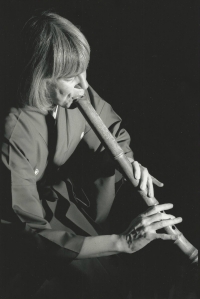On this visit, I was introduced to Japanese hosts in the temple town of Kamakura, who invited me to stay for three weeks in their empty in-laws’ house in the garden. Imagine having a whole Japanese house to yourself in Japan! I could not believe my luck. Kamakura is set up (as are many parts of Tokyo by the way), with tiny lanes barely big enough for a single car to pass, adjacent to the wider, more highly trafficked, two-laned streets.
Most of the houses are hidden behind high hedges. The sensation is of deep deep green, coolness, and quiet. And I was surrounded by nightingales, the most beautiful of sounds. Except for their calls, all you hear are the sound of footsteps in the street, then in the morning, the children come rushing and shouting on the way to school. It is so quiet that people remark on unusual noises. So although I never met them, my hostess told me I had became famous in the neighborhood because of my practicing.
We lived closest to Jyomyoji (Polish Your Heart Temple), and early on the first morning after my arrival, my hostess took me to see it. It was early May, and we were the first ones there. After paying the young Buddhist acolyte at the entrance, we walked up the stone steps that led to the covered gate, and stepped onto the gravel path leading towards the main hall. On each side of us we saw ancient plum trees, covered in lichen and moss, and the new green of spring leaves. When I looked more closely, I saw that their branches were covered with small flowering orchids. The wind came in warm gusts and sudden wild bursts, and a nightingale began its song.
I walked tasting the air, in an intoxication of the day. After visiting the Buddha, we spotted a dry garden surrounded by flowering azaleas, and wandered closer. A pavilion overlooked it, Would I like some tea — entering for tea was the best place to view the garden — (yes!) — so we stepped out of our shoes, and found a spot on the red felt carpet closest to the garden. Dark stones emerged from white gravel raked in arcs to depict water: a dry seascape. A young female monk brought the bowls of tea, for me a low squat bowl glazed in burnt Sienna with gobs of white; for S, a round white bowl that picked up the green of the tea; and sweets on small lacquer plates with a toothpick, We ate our wagashi sweets first (they are stamped with the name of Ashikaga Yorikane, the bushi who originally owned the land here), and drew three long draughts of the well-frothed, deep green, bitter tea.
My two official performances were in Kita-ku at Hokutopia, a hall where traditional Japanese musicians often play, and then at Nihonbashi Shakai Kyoikukaikan, in downtown Tokyo. The photo below was taken while I was performing Namima Reibo (Rythm of the Waves) in Nihobashi.
I also played twice at the home of a fan of mine who invites her friends and prepares a wonderful meal to eat afterwards. I needed to have my shakuhachi repaired, and was introduced to a very able young man by Aoki Shoji, my teacher Reibo’s son, and went every week for ensemble practice with one of the Reibokai koto (zither) teachers.
Another project was to meet a composer on the Sea of Japan, who was interested in writing a piece for the shakuhachi. She lives with her husband in an artists’ conclave in the woods. I arrived on the full moon of May, and after dinner, they asked me if I would like to go down and listen to the frogs under the full moon. Of course I said, “Yes!” We descended down a dark path from the house towards a pond. We could hear the sound of the Japanese bullfrogs going “meu meu meu” (not an American sound, so pronounce as in French, or between a “muh” and a “meh”) The moon was sailing high in the sky. With no electricity in any direction, the sky was pitch black. Then we moved towards the rice paddies. Immediately the air was filled with a roar of frogs, two kinds, one going “chakachakachakachaka” and the others going “wa wa wa wa” in synchopation. I could hardly hear myself think. If one of us began to say something, they would stop instantly; if we stayed quiet without moving, they would start up again, and from the other pond would come “meu meu meu” from the bullfrogs. And meanwhile the moon, hidden, came out from behind a cloud.
Below is a picture of me beneath a thousand-year old cedar at Eiheiji, a temple founded by the monk Dogen in the 17th century, to which my friends took me. Eiheiji has been the central temple for Soto Zen (known as slow Zen, as compared to the more well know Rinzai or fast Zen) in Japan, and young men bound to become priests at their home temples come here for training.





